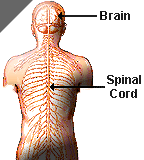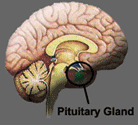The world's most popular psychoactive substance, caffeine, enjoys unprecedented popularity as a stimulating beverage in the form of coffee, tea and in a wide range of "energy drinks," the latter of which are hitting the market in rapid succession.
Even drinks targeted at younger markets, such as Mountain Dew and Coke, contain reasonable levels of caffeine—enough to warrant concern from various health authorities.
In the USA alone, the equivalent of 168 mg of coffee per person, or a cup and a half for each of its 275 million inhabitants, is consumed every day. Of course, many drink significantly more than this. Given caffeine is a drug, which makes it an addictive substance, are we getting too much of a good thing when we insist on our several morning coffees, and other caffeine containing products throughout the day?
It is hard to say exactly what the long term consequences of sustained caffeine use are, but one thing is fairly obvious: society in general, it seems, has formed a reliance on this 'worlds most preferred drug of choice' and its energizing effects.
What Is Caffeine: And How Does It Work?
History
It could be argued that caffeine, in addition to being the worlds most heavily used stimulant, was one of the first drugs to be used by a mass scale. Indigenous to Ethiopia, coffee began its climb to popularity in the Middle East in the fourth century AD.
The Chinese began tea-drinking thousands of years ago, and the Sufis of Yemen used it in the form of coffee in the 15th century as an aid to staying awake for their prayers—one legend has it that Bodhidharma, the 28th Patriarch of Buddhism in India, upon cutting his eyelids off to stay away longer for meditation, flung them to the ground upon which, on the exact same spot, the first tea plants grew.
Coffee houses spread to Istanbul, Cairo and Mecca in the 16th century. One hundred years later, coffee houses opened for the first time in Europe. As a popular substance, especially in its beverage form, caffeine, it appears, has sustained civilizations as they have grown and prospered.
Stimulating Effects
The attraction to caffeine—medically known as a trimethylxanthine (a xanthene alkaloid)—probably stems from the energizing, and stimulating effects it has on the brain—more on this later. Although it is taken in a variety of ways, many of which are pleasurable to the taste buds, pure caffeine in its isolated form actually has the appearance of a white, crystalline power, and tastes very bitter.
Before being used for commercial production, or sold in its natural state, caffeine is taken from, or found in, a variety of sources:
- Tea
- The coffee tree
- Guarana berries
- Kola nut
- Cocoa
- Yerba mate
Essentially a central nervous system stimulant, caffeine is used medically to stimulate cardiac function and as a mild diuretic (to produce urine production and help with water excretion from the body by inhibiting the reabsorption of sodium and water from the kidneys). However, its main use, as alluded to earlier, is as a recreational energy booster, which increases feelings of alertness.
Just How Much Caffeine Are You Consuming?
As mentioned, caffeine can be found in a variety of products. The quantity of caffeine found in these products can vary markedly, with many popular drinks containing staggering levels of caffeine compared to the average cup of coffee, which contains around 100 mg per eight-ounce cup. As shown below, caffeine can be found in many popular drinks, snacks and stimulant products.
How Does Caffeine Stimulate The Body?
Caffeine stimulates the body by activating the sympathetic branch of the central nervous system (CNS), which leads to an increased heart rate, improved blood flow and blood pressure to the muscles, a release of glucose by the liver and a decreased blood flow to the skin and inner organs.
 |
The Central Nervous System. The human central nervous system consists of the brain and spinal cord. These lie in the midline of the body and are protected by the skull and vertebrae respectively. The human central nervous system consists of the brain and spinal cord. These lie in the midline of the body and are protected by the skull and vertebrae respectively.
This collection of billions of neurons is arguably the most complex object known. The central nervous system along with the peripheral nervous system comprise a primary division of controls that command all physical activities of a human. Neurons of the central nervous system affect consciousness and mental activity while spinal extensions of central nervous system neuron pathways affect skeletal muscles and organs in the body. |
 |
 |
||
The CNS is stimulated by the hormone epinephrine (adrenaline), which is released from the pituitary gland, usually in response to a perceived threat.
 |
What Is The Pituitary Gland? A small oval endocrine gland attached to the base of the vertebrate brain and consisting of an anterior and a posterior lobe. A small oval endocrine gland attached to the base of the vertebrate brain and consisting of an anterior and a posterior lobe.
The secretions of which control the other endocrine glands and influence growth, metabolism, and maturation. Also called hypophysis, pituitary body. |
 |
 |
||
An effect called competitive inhibition, which causes an interruption to a pathway that normally serves to regulate nerve conduction (by suppressing post-synaptic potentials), occurs when caffeine, which is structurally very similar to the molecule adenosine, binds to the surface of adenosine receptors without actually activating them.
Adenosine plays an important role in sleep and wakefulness. Caffeine, by attaching to the adenosine receptors, prevents an over-accumulation of adenosine in the cells and, as a result negates its sleep promoting effects. This process is what ultimately causes the release of epinephrine and central nervous system stimulation.
Viewed in this light, caffeine could be described as a substance that thwarts one of the main processes by which the nervous system is calmed, not an energy producer in it own right.
Also, in our cells we have a molecule called cyclic AMP (a molecule that acts as a second messenger, which carries signals from the cell surface to proteins within the call) that serves as a messenger in the epinephrine release process. Caffeine causes Cyclic AMP to store in the cells, thus blocking its removal. This, in turn, intensifies and prolongs the actions of epinephrine.
Caffeine acts as an erogenic (it improves ones capacity for physical and mental work) based on its previously described effects, as well as the actions of its various metabolites (smaller molecules that serve various biological functions as products of metabolism). Caffeine's metabolites and their respective actions follow:
- Theobromine: Theobromine increases oxygen and nutrient flow to the brain, serving as a vasodilator.
- Theophylline: Theophylline relaxes the smooth muscles (most notably the bronchioles) and increases heart rate efficiency.
- Paraxanthine: Paraxanthine aids lipolysis (the breakdown of fat for energy).
Caffeine's Uses
With its popularity soaring, caffeine in it many guises is being used for reasons other than pure enjoyment. Let us take a look at the various ways caffeine is used.
1. As An Athletic Performance Enhancer
Caffeine is widely used in the athletic community as an erogenic aid. It has been reported as having such positive effects on sports performance as increased energy levels, reaction times and alertness, and improvements in endurance. Experts believe that caffeine causes the muscle cells to utilize proportionally greater amounts of fat than would otherwise be used under normal conditions.
The fatty acids released from the muscles—in the presence of caffeine—to sustain endurance work, are thought to have a muscle-glycogen sparring effect. Thus, glycogen can be used more readily during the latter stages of an event or workout, and the athlete will be able to train longer due to the utilization of the larger fatty acid energy stores.
This could be due primarily to one of caffeine's metabolites, paraxanthine, and its ability to aid lipolysis. The critical period in glycogen sparing is thought to occur in the first 15 minutes of exercise. During this stage, caffeine has been shown to decrease glycogen utilization by as much as 50 percent. It is also worth noting that the events or training sessions most likely to benefit from caffeine consumption have been shown to be longer duration (40 minutes or more), where the athlete is not using maximum effort.
As shown, caffeine stimulates the brain, and, in turn, activates the sympathetic branch of the central nervous system, increasing feelings of alertness. As a result, the body undergoes a positive transformation in the sense that it becomes more attuned to its surroundings and is quicker to respond.
This has obvious implications for the athlete, several of which include a reduction in the perception on physical effort during exercise, or an event, and increased reaction time, faster movement, and heightened awareness.
Heart rate efficiency is also improved, as is oxygen and nutrient flow to the brain. These can all contribute to improved athletic performance.
To gain improvements in athletic performance it is thought that two to three cups of coffee or an equivalent 200 mg in tablet form is best. However, this is subject to what the individual in question needs, or can tolerate, so there is no definitive advisable dosage.
2. To Improve Mental Acuity
Another of caffeine's erogenic effects is its ability to heighten metal acuity and improve cognitive function. It has been shown that 75-150 mg of caffeine will elevate neural activity in several parts of the brain, which assists with the completion of simple intellectual tasks—for example: relatively passive, automatic, data-driven tasks such as performing simple arithmetic, and auditory reaction time.
Although caffeine can help with more complex tasks (logical and numerical reasoning, complicated arithmetic and reading comprehension), this often hinges on the personality of the user and a series of other factors including time of the day and immediate environment. However, many people report positive benefits in taking caffeine before mental tasks such as studying for a test.
Caffeine is believed to aid memory. It is speculated that because caffeine plays a role in adrenaline (norepinephrine) production in the brain, and adrenaline, due to its fight or flight function, can improve memories for important and shocking events memory in other areas is enhanced with caffeine intake.
3. To Improve Body Composition
To lose fat, many are turning to caffeine in its most common form, coffee, or as a supplement to hasten lipolysis, or the breakdown of adipose tissue. Caffeine's metabolite paraxanthine mobilizes fatty acids to be used as fuel in place of glycogen. Caffeine is also thought to increase the thermogenic effect of food, which helps with total energy expenditure and weight loss. It is also thought to suppress appetite. Many of the weight loss supplements on the market today list caffeine as a key ingredient.
4. As Therapy
Caffeine is widely used as a pain reliever, primarily as a way to treat headache (one such product is Excedrin, which also contains acetaminophen and aspirin). As mentioned, caffeine works as a vasodilator, thus helping to increase blood flow to the brain to negate the painful effects of a headache.
Caffeine is also used to stimulate breathing in newborn babies with apnea (cessation of breathing) due to premature birth or surgery. Additionally, caffeine can be used in cases where breathing is depressed (such as when one overdoses with heroin or other opiates). Given its dilating effects on airways, caffeine is also thought to be useful in the treatment of asthma, with some studies finding modest benefits.
Is Caffeine Addictive?
Caffeine is an addictive drug that operates on the same pathways that cocaine, heroin and amphetamines use to produce feelings of energy through the stimulation of the central nervous system. Although milder than any of these other stimulating drugs, caffeine causes addiction in many: those who feel they cannot function without their morning coffee, and/or who need several cups throughout the day are probably addicted—a term, caffeinism, has even been coined to explain the abuse of caffeine.
With caffeine addiction, the body becomes oversensitive to a neurotransmitter in the brain called adenosine, when caffeine intake is reduced. This results in a rapid drop in blood pressure, and resultantly, an excess of blood in the head, and thus the commonly reported withdrawal headache associated with a reduction in caffeine. This signals addiction.
Caffeine withdrawal may appear within 12-24 hours after the final cup of coffee or other caffeine product. In addition to headache, symptoms can include fatigue, nausea, drowsiness, irritability and anxiety. Extreme cases may produce depression and diminished motivation and concentration levels.
As with many drugs, caffeine has a tolerance affect in that the more that is used, the lower the sensitivity one will have to it. This reduction in sensitivity means that as time passes, more will be needed to get the same effects. A good rule for those wanting to enjoy the performance effects of caffeine, without having to consume mass quantities, is to use it sparingly. In other words, use it when needed, rather than on a continual bases.
It is worth noting that if an athlete wants to use caffeine as an erogenic aid, for a sporting event or training session, it is best they abstain from it for 48 hours prior. When the body has built up a tolerance to its effects (in those who take in at least three cups of coffee per day), caffeine will probably not provide a significant glycogen sparing effect.
Conclusion
Caffeine is the worlds most widely used drug for several reasons: it provides a stimulating effect which often forms a reliance on its use, gives the user physical and mental benefits, is contained in many popular products, and is used for medical and therapeutic purposes.
It has been said that if caffeine consumption were to end tomorrow, 70% of the world's productivity would decline markedly; such is the widespread dependence we have for it. In light of its popularity and reported benefits, caffeine use in moderation may not necessarily be a bad thing. Just exercise caution, and enjoy.
View Top Selling Caffeine Products Here.
References:
- Aetna, InteliHealth.(2006). Coffee, Grounds For Concern? [Online]
- Davis, Payton N. "Various Effects of Caffeine on the Body." Clinical Nutrition Review April 1990.
- HARRIE. J.R, Caffeine and Headache. JAMA 213.4.628.1970
- LUTZ, E.G_ Restless Legs. Anxiety, and Caffeinism. J Clin. Psychiatr,, 693,1978.
- McNaughton, Lars. "Ergogenic Effects of Caffeine." Clinical Nutrition Review. January 1990.
- Trice, I., and Haymes, E. (1995). "Effects of caffeine ingestion on exercise-induced changes during high intensity, intermittent exercise". International Journal of Sports Nutrition. 37-44.
- Weinberg BA, Bealer BK. The world of caffeine. New York & London: Routledge, 2001. ISBN 0-415-92722-6.
